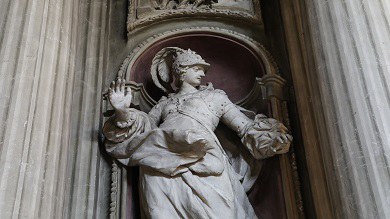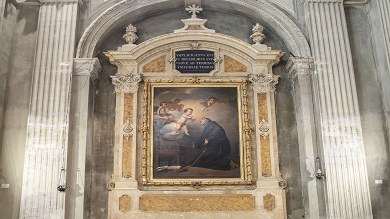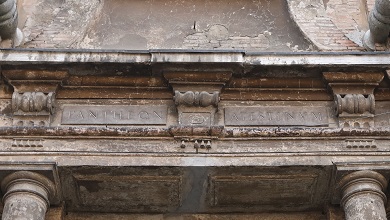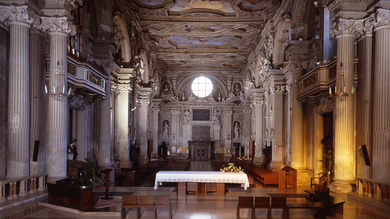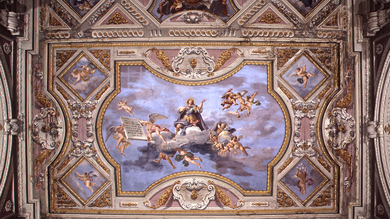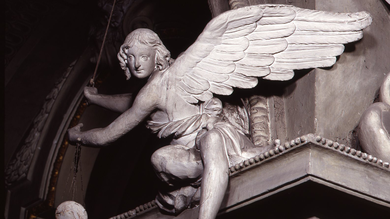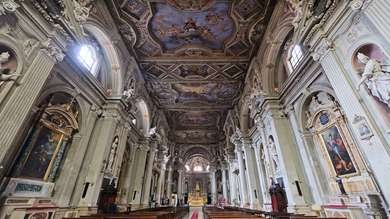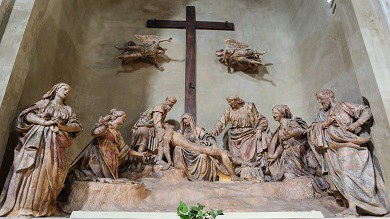Sant'Agostino Church
Of fourteenth-century origins, the church was transformed during the seventeenth century to become the Pantheon of the dukes and duchesses of Este.
It stands on the place where there was previously a church belonging, since 1273, to the Apostolic friars’ Congregation who rebuilt the convent complex after having been blended with the Heremits’ Order. The reconstruction began in 1338 and the church was named after Saint Augustine. Only the structure and the east side overlooking Via Sant'Agostino remain today of the early building. The only fourteenth-century decoration surviving today is the “Madonna col Bambino” by Tomaso da Modena, that was formerly painted on the outside of the building.
In 1659, Duke Francesco I d’Este's funerals were celebrated, creating an impressive and ephemeral display. When in 1662 the Duke Alfonso IV died, his wife Laura Martinozzi decide to change permanently the building interiors to transform it into the Pantheon Atestinum, the temple dedicated to the everlasting glory of the dukes of Este and of the European king connected with the Family, according to the iconographic program of the court scholar Domenico Gamberti. Without wrecking the structure of the building, the architect Giovanni Giacomo Monti redesigned the interiors with a stucco display, placing 47 statues, 12 busts and 12 reliefs. Several court artists were involved: Olivier Dauphin, Sigismondo Caula, Francesco Stringa, Lattanzio Maschio and Giovanni Lazzoni.
Relatives of the ruling family are portrayed along the nave, with inscriptions about individual virtues by their side. Above the statues, in the niches, episodes of the life of holy queens and empresses are depicted. Over the cornice there are the busts of the kings, as well as niches with queens and empresses. In the transept and presbytery, busts of popes and allegorical figures supporting medallions with bishops are on top of Este saints.
The painted ceiling was built with coffers painted with the glorification of some saints: St. Margaret of Hungary, the Glory of St. Henry the Emperor, the Beata Beatrice d'Este in the presence of Christ, Christ in glory flanked by the Virgin and St. Agostino, San Benedetto da Norcia and the glory of San Domenico di Guzman.
On the arch of the presbytery there is the fresco “Gloria di San Francesco di Sales” by Francesco Stringa, connected to Laura Martinozzi's personal devotion. The Altarpiece is by Francesco Stringa too, with Saints Agostino, Guglielmo, Monica and Tommaso da Villanova who are venerating the image of St Mary: this served as a frame for the 14th-century “Madonna col Bambino” by Tomaso da Modena, over the altar of the Madonna of the belt.
In 1785 the “Compianto su Cristo morto” by Antonio Begarelli was placed in one of the church chapels. The Carlo Sigonio's bust, above his burial place on the left side of the presbytery, is by Begarelli too. On one of the left altars there is a painting by Adeodato Malatesta depicting Saint Anthony of Padua. In 1881 the church was purchased by the Municipality of Modena. In 2018, at the end of the restorations after the 2012 earthquake, the church was reopened to the public.
Ownership: Municipality of Modena
Opening hours
Sant' Agostino Church opens to public from Monday to Saturday: 7 am - 12.30 pm and 4 pm - 7 pm; on Sunday 8.30 am - 7.00 pm.
Visits are not allowed during celebrations.
Tickets and admission
Free entrance.


